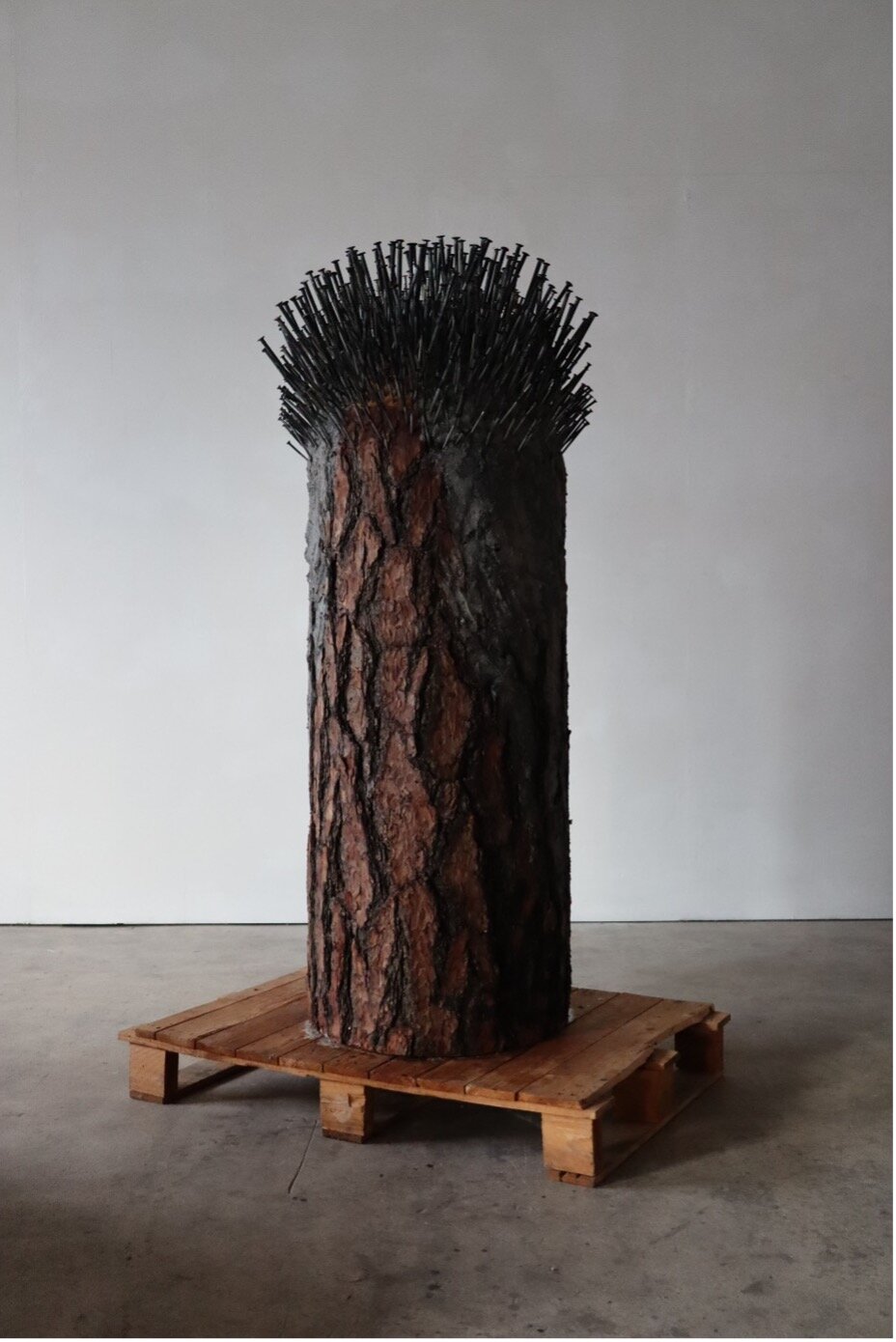Günther Uecker
Kunstpranger
2008, Tree trunk and nails on wooden pallet, 153 × 73 × 70 cm
Günther Uecker was born in 1930 in Wendorf, Germany. Studying painting at the Kunsthochschule Berlin Weissensee from 1949 to 1953, he left East Germany for the West, where he further pursued his artistic training from 1955 through 1958 at the Kunstakademie Düsseldorf. Throughout the 1950s, Uecker cultivated a strong interest in meditative practices and purification rituals, and became fascinated with the philosophies of Buddhism, Taoism, and Islam. He developed rituals of his own, including the repetitive hammering of nails, and proceeded to translate this practice into a central aspect of his work. Hammering dense groupings of nails into panels and readymade objects, he created reliefs that operate between painting and sculpture, and that establish new realms for visual exploration, wherein the patterns of surface, light, and shadow are complex and unpredictable. Multilayered in their meanings, these works are resonant with Uecker’s past, including his memories as a boy of nailing up planks to barricade the windows of his family home at the end of World War II. He also incorporates objects such as monochromatic paint, ash, sand, stone, glass, string, cloth, posts, tree trunks, and other media, using these elemental materials to create works of art imbued with the poetic spirit of order and chaos, creation and destruction. As Uecker declared in 1961, “My objects are a spatial reality, a zone of light. I use mechanical means to overcome the subjective gesture, to objectify, to create a situation of freedom.”
Uecker expanded his practice further in the 1960s by introducing kinetic and electrical elements into his works, while shifting his methodology from precise, geometric patterns to more organic and irregular arrangements. In 1957, Uecker first exhibited with Heinz Mack and Otto Piene, who founded the Zero Group, which he formally joined in 1961. They advocated for a new art form—a degree zero—to erase the destructive forces by which human experience had come to be conditioned during the war, and which were expressed in the then-prevalent art informel style. Central to the movement were explorations of light, technology, and an expansion beyond traditional two-dimensional confines of the canvas, all of which are explored by Uecker.
After the dissolution of Group Zero in the mid-1960s, Uecker's work became increasingly performative, incorporating aspects of body, conceptual, and land art. Starting in the 1970s, he has designed stage sets for several operas. He taught at the Kunstakademie Düsseldorf from 1974 to 1995 and was promoted to professor in 1976. In 1978, Uecker created the multipaneled wall relief Von der Dunkelheit zum Licht (From Darkness to Light) for the United Nations Office in Geneva. In 2000, he designed a Reflection and Prayer Room for the reconstructed Reichstag in Berlin.
Uecker participated in documenta, Kassel, in 1964, 1968, and 1977, and the Venice Biennale in 1970. His work has been exhibited at museums around the world, including one-artist exhibitions at Kunsthalle Bern (1966); Staatliche Kunsthalle Baden-Baden (1968); Moderna Museet, Stockholm (1971); Kunstmuseum Düsseldorf (1975, 2015); Staatsgalerie Stuttgart (1976); Nationalgalerie, Berlin (1982); Instituto Aleman de Madrid (1988); Museum Moderner Kunst Stiftung Ludwig Wien, Vienna (1992); Museu de Arte Moderna, Rio de Janeiro (1996); Martin-Gropius-Bau, Berlin (2005); Ulmer Museum, Ulm (2010); Tehran Museum of Contemporary Arts (2012); and Museo Nacional de Bellas Artes, Havana (2014); and the Imam Ali Religious Arts Museum, Tehran (2016). The Central House of Artists, Moscow, staged a retrospective of Uecker’s work in 1988. This exhibition was followed in 1993 by a retrospective at Kunsthalle der Hypo-Kulturstiftung, Munich, and a large-scale presentation of his oeuvre was organized by Kunstsammlung Nordrhein-Westfalen, Düsseldorf, in 2015.
Uecker has been the recipient of numerous accolades, including the Goslarer Kaiserring in 1983; induction into the German Pour le Mérite order for Sciences and Arts in 2000; the Berliner Bär, B.Z. Kulturpreis, Berlin, in 2005; the Great Federal Cross of Merit from the Federal Republic of Germany in 2006; the Jan-Willem-Ring from Dusseldorf in 2010; and the Staatspreis des Landes Nordrhein-Westfalen in 2015. Public institutions that house the artist’s work in their collections include the Art Institute of Chicago; Solomon R. Guggenheim Museum, New York; Museum of Contemporary Art, Los Angeles; Museum of Modern Art, New York; Walker Art Center, Minneapolis; Hamburger Bahnhof, Berlin; Peggy Guggenheim Collection, Venice; Museum Ludwig, Cologne; Centre Georges Pompidou, Paris; Staatsgalerie, Stuttgart; Stedelijk Museum, Amsterdam; and Tate Modern, London.
In 2011, L&M Arts exhibited Günther Uecker: The Early Years, the artist’s first major exhibition in New York for over four decades. This exhibition featured the artist’s paintings, panels, and structures dating from the late 1950s through the 1960s. In 2016, Dominique Lévy presented Günther Uecker: Verletzte Felder (Wounded Fields), the first exhibition of his work in London for over fifty years. To create this new body of work, Uecker painted canvas-covered panels with thick white pigment, hammered dense groupings of nails into their surfaces, and split the some of the panels with an axe, creating deep gashes that disrupt the integrity of their surfaces with a striking gesture. In 2019, Lévy Gorvy opens Günther Uecker: Notations uniting new large-scale nail paintings with a collection of watercolors created by the artist during his global travels.


